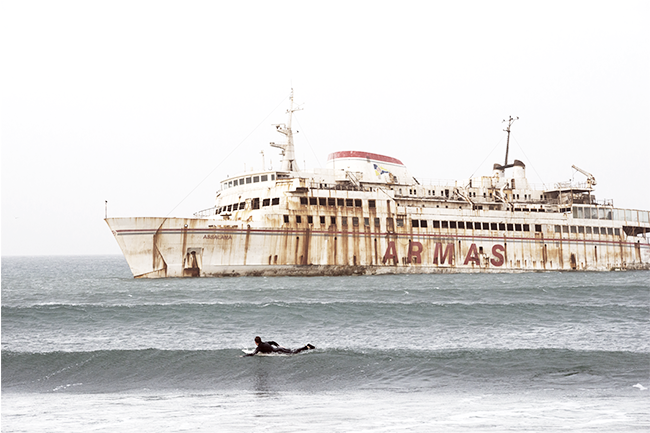South African-based salvage operators have a long record of remarkable achievements. Among their earlier successes was the refloating of the Australia-bound Aotea that had grounded in Table Bay, Cape Town in January 1911.
On board was a consignment of dynamite, which posed a serious threat. Within hours of the stranding, stevedores gingerly discharged the boxes of explosives into lighters – a wise move as a fire broke out in a coal bunker near the steamer’s stern a few days later.
Once the fire had been extinguished, the rest of the cargo was expelled into a small coaster that managed to come alongside the stranded vessel, and made several trips to the harbour to land the cargo.
As rocks had penetrated Aotea’s hull – making much of the vessel tidal – salvors were faced with the difficult task of refloating it. By sealing some of the holes and using power-
ful pumps, they succeeded in gaining some buoyancy. With the ship’s anchors laid seaward and power supplied to the winches, a combined pull of 80 tons on the cables saw the ship move slightly. Gaining more buoyancy, it was freed from the rocks by a tug.
A thorough survey showed that it would be safe for Aotea to enter the harbour and settle onto the sandy bottom, allowing all remaining cargo – steel and pig iron – to be discharged. Proper sealing of the gashes in its hull was also carried out prior to dry-docking for a full assessment of the ship’s condition.
After surveyors had determined that it was worth repairing, engineering teams began work in Cape Town’s Robinson dry dock. This was a lengthy job as new steel needed to be brought from the UK. Once repaired, Aotea continued trading.
Backed by sound local engineering capacity and salvors’ expertise, even such a seemingly hopeless situation could be addressed – a theme that continues today.
Over the years, South African salvors have shown their mettle – from the salvage of damaged vessels in World War I, recovery of large quantities of blister copper from Hypatia – ashore on Whale Rock in Table Bay in 1929 – and on numerous occasions during World War II, to dozens of other maritime dramas.
One such incident was the remarkable refloating of the Ellerman freighter City of Lincoln that went ashore at Quoin Point near Cape Agulhas in 1946. The technique used on this occasion – sealing all hatches and vents before pumping compressed air into the ship to gain buoyancy – was among the first of its kind.
Based in South African ports, German, British and Dutch tugs had undertaken several salvage operations off the coast but local authorities could not depend on foreign operators. For this reason a locally operated and contracted standby salvage tug system – focused on two fast and powerful tugs – was initiated in South Africa in the late 1970s. The system is now emulated by many other countries.
From these and numerous other operations that had been overseen by experienced salvage masters, emerged a corps of well-trained younger officers whose record confirms South Africa’s leading role in salvage operations in Africa and further afield.
An integral part of salvage operations is oil spill prevention or containment. The bunker capacity of some larger ships is over 5 000 tons
Even though the shipping industry has reduced the number of ‘rust buckets’ through tight controls and frequent inspections of ships, the human factor remains the main contributor to maritime accidents.
Although no major incident has occurred off the Southern African coast since the stranding of the handysize bulker Kiani Satu in August 2013 and the wreck of the capesize bulker Smart at Richards Bay two weeks later, the risk of an accident along the Southern African coast has actually increased.
Despite the global shipping downturn, the expansion of trade between Asia and South America and West Africa has increased traffic around the Cape. The low bunker prices have also caused a number of shipowners to switch their vessels that are carrying non-time-sensitive cargoes to the Cape route. This is an attempt to avoid the higher Suez Canal tolls, piracy insurance surcharges and the costs of having armed guards aboard their ships.
Among the vessels steaming between the western and eastern hemispheres are ultra-large bulkers moving iron ore from Brazil to Asia. More of these vessels will be on the Brazil-China trade route soon, given that – besides those already on order – a further 20 of these enormous vessels have been ordered this year alone.
Laden tankers carrying oil from West Africa to the East – and those heading to West African terminals for loading – are also regularly seen off the coast. These numbers are set to increase as Brazilian oilfields extend their production for Asian customers.
These factors have increased the number of ships passing Cape Agulhas – now between 40 and 50 a day, often more than the daily transits through the canal. Most pass within a narrow 25 nautical mile sea area south of Cape Agulhas.
This densification of traffic increases the risk of an accident, as do frequently adverse sea conditions along the Southern African coast, with swell heights occasionally exceeding 10m in winter.
Fog occurs often from the north of Walvis Bay to Port Elizabeth, and inshore sets are encountered – especially along the South African east coast – posing a danger for passing ships where watchkeeping may not be up to standard in some vessels.
An integral part of salvage operations is oil spill prevention or containment. The bunker capacity of some larger ships is more than 5 000 tons, which is equivalent to the cargo capacity of a small products tanker, and if the unthinkable happens, salvors could be tasked with the recovery of thousands of tons of heavy fuel oil.
If disabled offshore or aground, a large, laden immobilised vessel would require the services of a powerful tug with an adequate displacement weight to overcome the initial inertia of such a ship and to keep it moving, while speed is essential to ensure that a salvage vessel reaches the casualty as quickly as possible.
Although 40 years old, the current contracted standby tug – the Cape Town-based Smit Amandla – is fast, powerful and has a good displacement to satisfy these requirements.
In the wake of the collapse of the offshore oil industry, numerous tugs have been laid up, but these are mostly anchor handlers with no after-deck gunwale, with limited speed and burning expensive gas oil, rendering them not ideal – or uncompetitive – for salvage where speed and cheaper fuel consumption are preferable.
While Smit Amandla Marine and its ancestral companies have provided South Africa with a successful and respected salvage and ocean towage service since 1976, considerable restructuring of that sector will occur with the entry of several other contenders for the contract to operate the standby emergency towing vessel.
Among these is the world-renowned Resolve Group, whose personnel include some well-known salvage experts such as Nick Sloane.
Apart from the establishment of a local base with all the necessary equipment, a standby salvage tug – formerly on the UK coast – will arrive in South Africa to enhance Resolve’s salvage and towage response capability.
Also available to the local operation is the company’s international fleet of sheerleg crane vessels, naval architectural services and training academy.
Ardent – a company created by two established salvage operations, Svitzer and Crowley – launched a joint venture with undersea salvage and diving operators Subtech. The firm is now an integral part of the salvage sector and has demonstrated its abilities with the successful removal of the wrecked capesize bulker Smart outside Richards Bay harbour between 2013 and 2015.
Others may also enter the salvage sector and realignments are likely to occur. The immediate aim of existing salvage operators as well as newcomers will be to secure the South African standby emergency towing vessel contract, scheduled for renewal later
this year. Government may also decide that it should own and operate the standby tug, although such suggestions bring frowns from private enterprise.
Whichever company operates the tug must demonstrate a thoroughly professional approach and have at its disposal an experienced team to handle a potential national crisis (which a major maritime disaster could become), as well as have vessels and equipment on immediate call.
Salvage operations are a serious business and in the interests of all, it should be left to those in the forefront of the sector.
By Brian Ingpen
Image: Gallo/GettyImages



